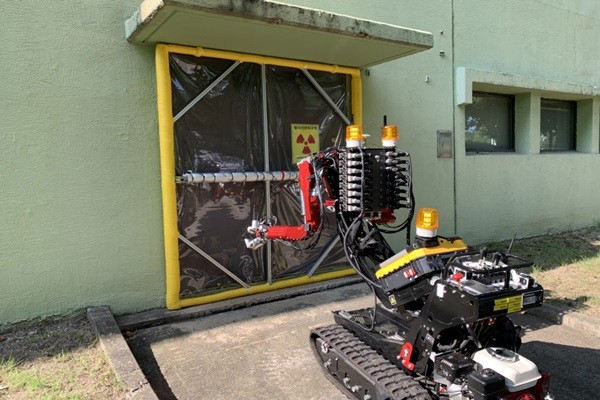Korea Atomic Energy Research Institute (KAERI, President Park Won-seok) announced on Monday that the institute now has an unmanned disaster prevention system for accidents involving nuclear energy that is assisted by the institute’s robots.
The institute has formed a disaster prevention system with an indoor monitoring robot “TRAM”, an outdoor monitoring robot “RAM”, and an accident response robot “ARMstrong”.
TRAM is equipped with radiation and temperature detectors and is able to go over stairs and obstacles. It looks like a small armored car and its height is only 30 centimeters. It is able to prepare information on amount of radiation at the accident scene, thermal image, and 3D map in real time and send the information to appropriate agencies.
RAM remotely controls a commercial ATV (All-Terrain Vehicle) and load necessary equipment such as radiation detector and is able to go at a speed of 60 km/h. It works collaboratively with an aerial monitoring drone and observe the accident scene and draw a radiation contamination map from various angles.
ARMstrong is equipped with a hydraulic system and it is able to freely move around and go through rough grounds using caterpillar tracks while holding up to 200 kilograms of objects with its arms. It is able to carry heavy objects such as concrete or waste drums, spray firewater, or dispose wreckage or control valves. Because the arms of ARMstrong move the same way as “Master Device” that has a shape of a human arm, ARMstrong can also be used to work on delicate tasks such as assembling heavy pipes or plugging in LAN connectors.

Effectiveness of the three robots was proven as they were used in an actual disaster prevention training recently.
The institute conducts radiation prevention training based on various scenarios at least twice a year in order to verify effectiveness of its radiation emergency measures. Since 2016, it had conducted six trainings and it has verified effectiveness of its robots and improved the robots continuously.
During trainings that took place in August and October, TRAM was used to enter a building and send information about the accident scene to a control center while ARMstrong was used to seal the entrance of the building where radioactive materials were leaking from by spraying urethane foam.
The KAERI is the first government agency or company in the world to conduct a training involving a robot sealing the entrance of a building where radioactive material is suspected and it has proven South Korea’s excellent technology in the field.
“We have only taken a baby step towards setting up a robot-based disaster prevention system.” said Jung Kyeong-min who is the head of the institute’s Robot Application Research Department. “Through continuous improvements, we are going to do our best to establish a disaster prevention system that the people in South Korea can fully trust.”
Park Jin-ho, who is the head of the institute’s Nuclear Safety Research Institute, said that the institute plans to actively incorporate the Fourth Industrial Revolution technologies and do its best to reach a second stage where the institute’s robots can support a national response system and a third stage where the institute can establish an international cooperation system with foreign disaster prevention agencies.
Staff Reporter Kim, Youngjoon | kyj85@etnews.com